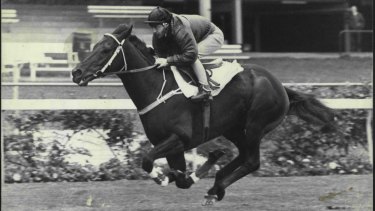Leaving on top was fit for a King so it’s time to let the queen go
Source: SMH /
After Saturday in the Queen Elizabeth Stakes the legend of Winx should be allowed to blossom further in memory and not on the racecourse.
Yes, this champion of champions has never raced better: a seven-year-old freak with the horsepower of a four-year-old which could possibly take a fifth Cox Plate or even put more fizz into the champagne at Royal Ascot.
But 33 wins straight, notched under Aussie eyes, is a record to be cuddled and Winx should leave healthy and intact.
Hugh Bowman, who knows her so well, reckons Winx has more to give which opens the possibility that Saturday may not be her swansong.
Alas racing now is at the crossroads of public opinion. No doubt animal activists will be on the squawk outside Royal Randwick this week.
Until more recent decades champions being beaten didn’t carry the same gravitas but being so good for so long makes Winx special.
The only time the industry has ever been under such pressure regarding horses was when the newspaper barons called for the scratching of Tulloch from the 1957 Melbourne Cup maintaining he was a three-year-old and too young to carry 52.5kg which would have only been useful ballast.
Until more recent decades champions being beaten didn’t carry the same gravitas but being so good for so long makes Winx special.
However Bradman wasn’t at risk of being felled by a Harold Larwood headshot at that stage.
Even Tommy Smith, who preached that thoroughbreds were meant to race not cavort in paddocks, hardly risked Kingston Town after the light of his career was dimming.
When it was announced Kingston Town was going to make a comeback I wrote that his legendary status should not be jeopardised.

Kingston Town officially retired in 1982 following the Western Classic victory in Perth. Two years later, after his suspensory ligaments were patched up, the gelding went to the famous Charlie Whittingham as a northern hemisphere nine-year-old.
“He wasn’t any spring chicken and running on old tires,” Whittingham recalled to Graham Kelly for The King.
“There’s no place in racing like California for speed but they don’t run any faster than he did (in a track gallop).”
“Risk is an inherent of racing unfortunately,” Hains told Kelly, a quote that can be applied to the Winx situation now.“ Every horse and every jockey are at risk when they go onto a racecourse. I believed Kingston Town was safer racing than in a paddock.
“I was fully aware there would be a mixed reaction about returning Kingston Town to racing. We came to the conclusion the opinion of other people was just something we would have to live with.”
Kingston Town was nominated and accepted in races after brilliant workouts. Ultimately, he lived up to Smith’s pledge of never racing again leaving the memory intact.
It wasn’t as pleasant for Bernborough. Sure, the stallion was only fifth in the last race he completed – the 1946 Caulfield Cup – but it was a great performance under 68kg which would bow the back of many top-liners who came after him. Apart from the handicap jockey Athol Mulley had to stay out of harm’s way as rivals added to the difficulty.
Bill Briscoe took over the reins in the Mackinnon Stakes at Flemington, which eventuated in a scene described by Bill Sigley in Mighty Bernborough.
“A loud noise like a sharp clap of thunder or a gunshot rolled over Flemington,” Sigley wrote. “Bernborough faltered and veered towards the middle of the track. The noise was so loud that Briscoe thought for a second that Bernborough had been shot.
“Bernborough’s near foreleg crumbled beneath him and only Briscoe’s skill stopped him from falling …
“The greatest galloper since Phar Lap, with physique to match his magnificent ability, was anchored in the middle of the Flemington straight.”
Fortunately Bernborough survived and became a successful stallion in the United States.
We want to see Winx on Saturday depart Royal Randwick majestic, fitting for a Queen of the turf, and leave it at that.




